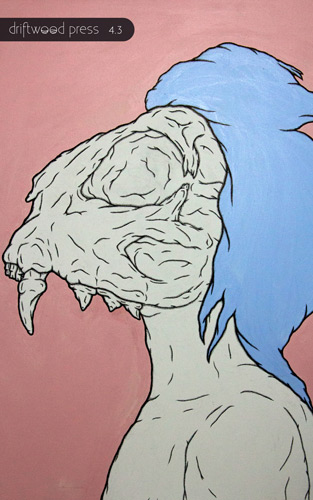Driftwood Press – Summer 2017
Some of my favorite literary magazines are those that introduce and connect me to artists and writers I was unfamiliar with prior to reading. While it’s definitely nice to read work by favorites, I am always open to finding something new. The latest issue of Driftwood Press accomplishes this twofold. First, it introduced me to a cover artist I was unfamiliar with. Second, it connected me to writers, each piece accompanied by an interview with its creator.
Some of my favorite literary magazines are those that introduce and connect me to artists and writers I was unfamiliar with prior to reading. While it’s definitely nice to read work by favorites, I am always open to finding something new. The latest issue of Driftwood Press accomplishes this twofold. First, it introduced me to a cover artist I was unfamiliar with. Second, it connected me to writers, each piece accompanied by an interview with its creator.
This issue’s cover art by Bort first drew me in. Looking almost like Dr. Seuss made a macabre version of Things 1 and 2, the illustration begs readers to take a closer look, curiosities piqued. Appreciating the cover art lead me to Bort’s website which features wide-eyed graffiti creatures that peep from shadows and behind bushes. I happily lost myself in the pages of the artist’s website before making my way back to Driftwood Press.
Once focused on the writing in front of me again, I was immediately drawn into the fiction, especially “Replica” by Stephen Hundley. Rob lives in his deceased brother Peter’s old life, married to his wife, Sarah, and caring for his son, Johnsey. This life happens to be parked in the past: he’s a Civil War reenactment soldier; their house is an electricity-free, remodeled train car in the woods; and they live their life without modern comforts, like cars and phones. Even after Peter’s death, Sarah can’t abandon the alternative lifestyle and Rob stays as well, sneaking modern desserts to his stepson and peeping at a neighbor’s TV through their window to watch cartoons with the boy. Rob gives Johnsey glimpses of the world outside and these glimpses also include childhood photos of Peter, another modern treat they share in secrecy. But being Peter’s replica in his old-fashioned life—a life which is a replica of old times that Sarah obsesses to authenticate at any cost—becomes too much, and things explode one evening as Rob pushes against the walls his little brother built.
Hundley’s interview after the story sheds light on the inspiration for and writing process of “Replica.” Knowing about the tweaks and different drafts lends greater appreciation for the finished product and the complex characters inside. I would love to see more of this family navigating their unique lifestyle, but incidentally Hundley answers whether there might be an expansion: not at the moment. Readers will have to stay tuned to see what other words he does end up sharing next.
In poetry, the interviews are especially welcomed, offering insight to an art form that’s process is often quite personal and relatively private. Kicking off the section, I enjoyed reading “Sledding with the Dead” by Michael Foran. The following interview shows readers the different sources of inspiration that that lead Foran to his finished product, allowing us to go back and look for those elements in play. We see his son’s words for headstones: “dead stones” and the sled tracks that inspired Foran: “exposed like early wounds / but already scab-like.” Juxtaposing the youth and energy found in the act of sledding against the cemetery setting makes for an even more compelling read.
Betsy Johnson-Miller reveals the poem “true story” arose out of an “I remember/I don’t remember” writing prompt and was originally twice its length before being cut down. What she leaves us with is just enough, and reads the way a memory might: some gaps in places, some jumping around, some parts of the original event now absent.
Daniela Matei writes on the memory of winter in Chicago in “Nest in the city,” a piece that delivers the city in gritty flashes, beginning:
a milky condom
the night gripped
high risers and
rusty scaffolds
None of the images are especially appealing on their own and give a sense of loneliness, of being forgotten, left to rust or rot on the sidewalk. Matei writes in her interview that the poem was inspired by “adjusting to life in a big city, to the new shapes and sounds, the brightly lit nights, the uncomfortable and frosty space.” She succeeds, the poem carrying a chilly feel as we attempt to nestle into it.
The issue closes out with a selection of art: a repeat of Bort’s untitled cover art, a series of photographs of “New Orleans People” by Jason Kerzinski, a photo and interview with Nicholas J.J. Smith, and a collage by Thomas Terceira. I loved each of these, and couldn’t pick a favorite if I had to, a good end to a solid issue.
Driftwood Press has readers covered when it comes to innovative writing, eye-catching art, and enlightening author interviews. Check out the latest issue to connect to the talented writers and artists inside.
[www.driftwoodpress.net]





